
A CLANK like a monk’s gong rang out as the researchers marched single file up a forested flank of the Rincón de la Vieja, an active volcano in north-west Costa Rica. When they stopped alongside the giant buttressed roots of a strangler fig tree, graduate student Nel Rodriguez Sepulveda of Michigan Technological University held up a small steel chamber, the source of the sound. Katie Nelson, a fellow grad student, tapped her tablet and a machine strapped to Rodriguez Sepulveda’s back began to buzz, noisily sucking air from the steel chamber through a hose. After a few minutes, Nelson glanced at her screen. “It’s elevated!” she whooped.
I had joined the scientists on a hunt for a notorious gas that seeps imperceptibly from fissures in the volcanic bedrock. They had come to map the places where it is more highly concentrated in the air than normal, in preparation for an experiment that could finally solve a mystery with profound consequences for the fate of our planet: whether tropical forests will continue to soak up large amounts of carbon dioxide, crucially slowing the pace of climate change.
We have always assumed as much. But increasingly we aren’t so sure, raising the prospect that global warming could unexpectedly accelerate. Now the race is on to find out how rising temperatures will affect the ability of tropical forests to lock up CO2, a question with urgent policy implications. Which is why the natural laboratory provided by the volcano is so important. “It could be a game changer,” says Josh Fisher, an ecologist at NASA’s Jet Propulsion Laboratory in California, who led the expedition.
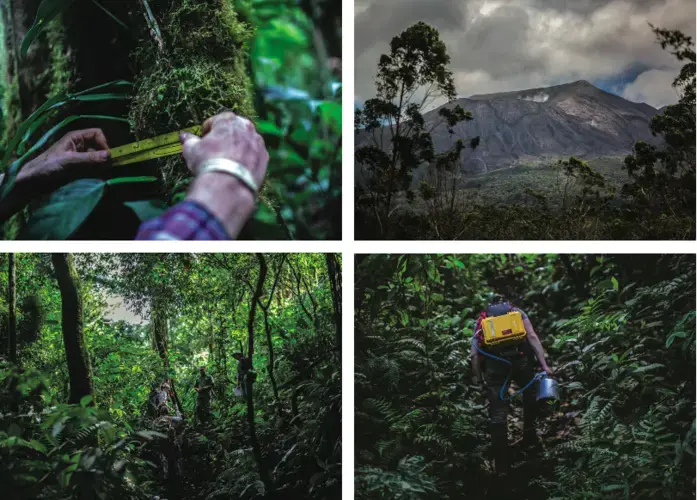
As worrisome as rising seas, intensifying storms and more frequent heatwaves are, climate change could already be a lot worse. Since the industrial revolution began, only about half of all the CO2 released from chimneys and exhaust pipes has remained aloft in the atmosphere. The balance has been soaked up by the oceans and by plants on land, both living and dead.
These natural carbon sinks have played an indispensable role in slowing the accumulation of CO2 in the atmosphere and so moderating global warming. Carbon absorption on land is particularly crucial. It is the larger of Earth’s two sinks and the one generally thought to be most in danger of abating in the coming decades. Combined, the world’s terrestrial plants absorb some 12 gigatonnes of CO2 every year, equivalent to nearly a third of global emissions from burning fossil fuel. This is all thanks to photosynthesis, the process by which water and CO2 is converted to oxygen and organic compounds such as sugars and cellulose. Grasslands, peat bogs and forests of all stripes contribute to the stockpile of locked-away carbon (see “The other carbon sinks.”). However, various lines of evidence suggest that tropical forests could be the single largest terrestrial carbon sink, with one influential study calculating that they absorb as much carbon as boreal forests and mid-latitude temperate forests combined.
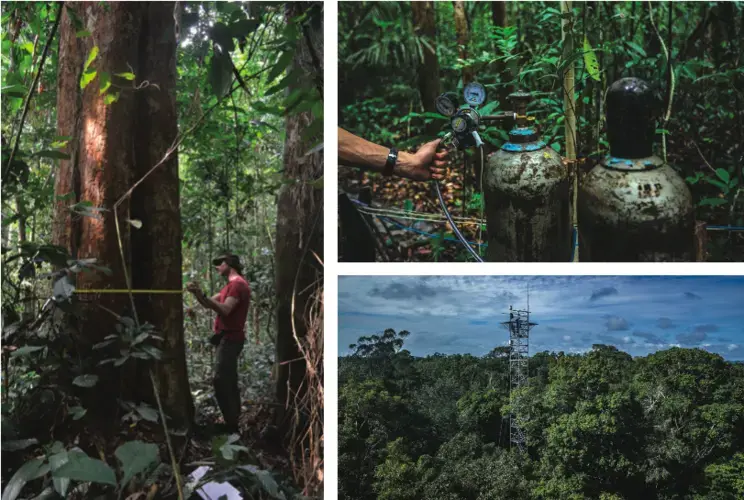
The problem is that equatorial jungles could also be uniquely vulnerable. Steeply rising temperatures and drought are forecast to create more inhospitable conditions in the coming years. Most predictions, including the latest report from the Intergovernmental Panel on Climate Change, assume that the land sink will continue to robustly stockpile CO2, buffering its build-up in the air. But if tropical forests decline, will this sink hold up?
It is vital we find out because if the answer is no, we are vastly underestimating the rate of warming. Forecasts of the future of the land sink are “highly uncertain,” says Richard Betts, who leads research on climate impacts at the UK Met Office. But in an analysis published in April, Betts wrote that if the land sink fails, temperatures at the end of this century could be nearly 2°C warmer than most predictions suggest.
Recent studies report troubling evidence of tropical forest decline. One from March was based on surveys of carbon uptake in the world’s two great tropical forests, the Amazon and the Congo. Hacking their way through thick jungle to find plots marked out years before, an international team coordinated by Simon Lewis at the University of Leeds, UK, were able to measure the girth of nearly 140,000 trees in 11 African countries. Calculating the mass of carbon in each tree and comparing the figures with measurements taken in previous decades and a database of 200,000 Amazonian trees, the researchers found that intact tropical forests in both regions seem to be absorbing less carbon than they once did.
The decline appears to be happening faster in the Amazon, where intact forest absorbed 30 per cent less CO2 in the 2000s than it had 10 years earlier. That led the team to a grim conclusion: even the parts of the Amazon not devastated by logging are likely to turn from a carbon sink into a carbon source by 2035. That suggests that we may not be able to rely on tropical forests to keep soaking up carbon after all.
But the science isn’t entirely settled. Jungles are extremely heterogeneous, so it’s possible Lewis’s field team studied a biased sample. The 244 survey plots covered a total area smaller than New York’s Central Park, a minuscule fraction of the Congo forest, which is twice the size of France, Spain and Germany combined. “That’s a lot of extrapolation,” says Scott Denning, a climate scientist at Colorado State University. The decline in carbon uptake found on these plots may not be replicated everywhere else, so “you have to be appropriately sceptical”.
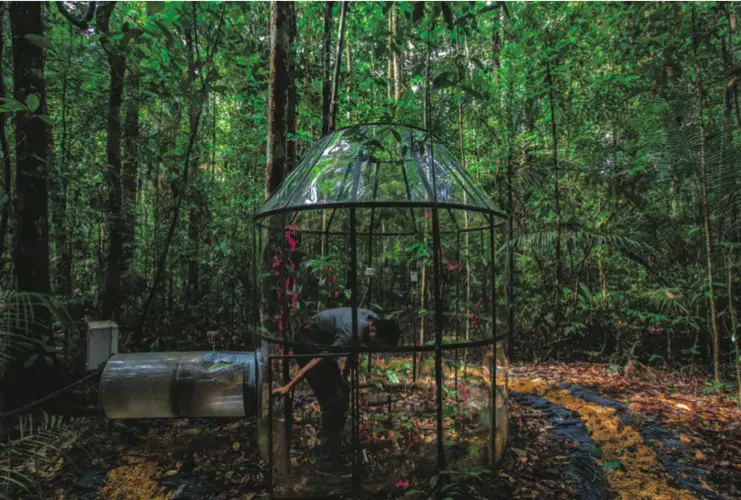
There is a glimmer of hope that higher CO2 levels will instead help tropical forests to continue soaking up carbon, even as other conditions deteriorate. The concept, known as carbon fertilisation, makes sense in principle: add more of one crucial ingredient to the photosynthetic recipe, and you can expect improved growth. Commercial greenhouse operators have long piped in the gas to boost the growth of certain crops. The trouble is that the extent to which it works in the jungle, with so many other factors influencing forest health, is hard to establish.
It isn’t that people haven’t tried. Richard Norby at Oak Ridge National Laboratory in Tennessee has run several experiments studying carbon fertilisation in full-size trees in natural conditions. As early as the 1990s, he erected a ring of towers around a plot slightly larger than the centre circle of a football field in an old sweet gum plantation near his office and proceeded to pump in CO2-enriched air through pipes hanging above the plot. Sure enough, the trees grew faster – at first. But they eventually slowed when the soil ran low on nitrogen, more of which appears to be required for those trees to benefit from extra CO2.
Scientists have since run similar studies, dubbed free-air CO2 enrichment, or FACE, experiments elsewhere in the US, Europe and Australia. Sometimes the extra CO2 helps. Sometimes it doesn’t. But no such experiment has ever been conducted in a tropical forest – which is critical, says Norby, because every ecosystem has its own quirks.
David Lapola is among those trying to change that. A biologist at the University of Campinas in Brazil, Lapola has spent the best part of a decade setting up a FACE experiment on a jungle plot 90 kilometres north of Manaus, the Amazon’s largest city. When I visited last year, workers trudged back and forth under a dense canopy hauling long, rigid panels of clear plastic mounted in aluminium frames. They were assembling the pieces into eight roofless chambers, each the size of a small garden shed.
Lapola was getting set to start supplying the chambers with CO2-enhanced air. He later told me that, although some plants do seem to grow better with extra CO2, provisional results “do not seem to show much of a difference between enriched and control chambers.” This suggests carbon fertilisation might not take up the slack. Norby says that may be because the soil at the site, as in much of the Amazon, is deficient in phosphorus, another essential plant nutrient.
But results from this experiment are far from definitive. Lapola is the first to admit that huge, unenclosed plots are superior. His small chambers let in normal light and rain, but beyond that the conditions inside them are highly artificial. For instance, the plastic walls block out wind and restrict access to birds, insects and rodents. Worse, they are only big enough for short plants – and Lapola says full-size trees in bigger plots could behave very differently.
No one is suggesting we should stop protecting tropical forests. But as we seek to avoid runaway climate change, scientists are increasingly urging us to pay attention to other terrestrial carbon sinks.
The problem comes down to money. Running an open-air experiment here would require thousands of tonnes of CO2 each year, at a cost of several hundred thousand dollars. That’s a big part of the reason Lapola and his collaborators, including Norby, have never managed to fund such an experiment in the rainforest.
Now, though, after getting some results from chamber experiments, the researchers have attracted interest from government agencies in Brazil and Europe to fund the construction of a full-scale, open-air fertilisation trial. It will involve six large, circular plots, three of which will be bathed in air fed from 35-metre-tall towers and spiked with CO2 to simulate concentrations expected in the mid-century. Betts has been waiting for such an experiment for years. “It would be a huge bonus,” he says.
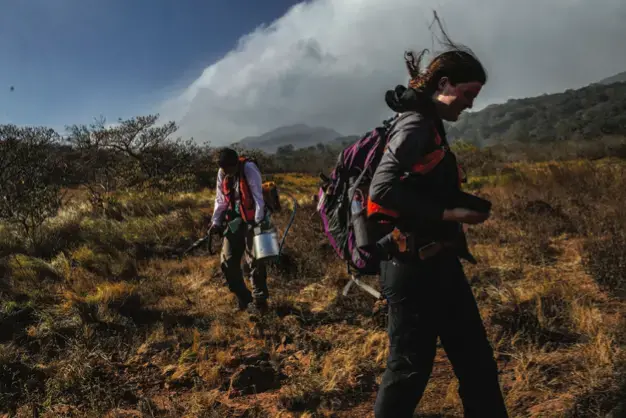
In the meantime, our best bet to find answers is the experiment on Rincón de la Vieja in Costa Rica. When I joined the researchers there earlier this year, they were mapping CO2 hotspots. Being heavier than air, as it seeps from the volcano’s bowels, this gas hugs the ground and flows into valleys, creating a patchwork of areas with high and normal concentrations of the gas. That is the theory anyway. Few researchers have ever surveyed CO2 concentrations on slopes of volcanoes, and nobody has enlisted a volcano to study carbon fertilisation in a tropical forest.
Fiona Soper, an ecologist at McGill University in Canada, applies the same simple techniques that Lewis used in the Congo basin to study Rincón de la Vieja’s jungle. While Rodriguez Sepulveda and her colleague Nelson sampled the air, Soper and her team identified and measured trees inside a 10-metre-diameter circle. Working with another team elsewhere on the volcano, they logged 1000 trees in 60 plots. Meanwhile, the gas sampling team detected CO2 levels ranging from just over 400 parts per million – the current global average in Earth’s atmosphere – all the way up beyond 600 ppm, an amount that we might find across the planet by late this century if today’s emissions continue unchecked.
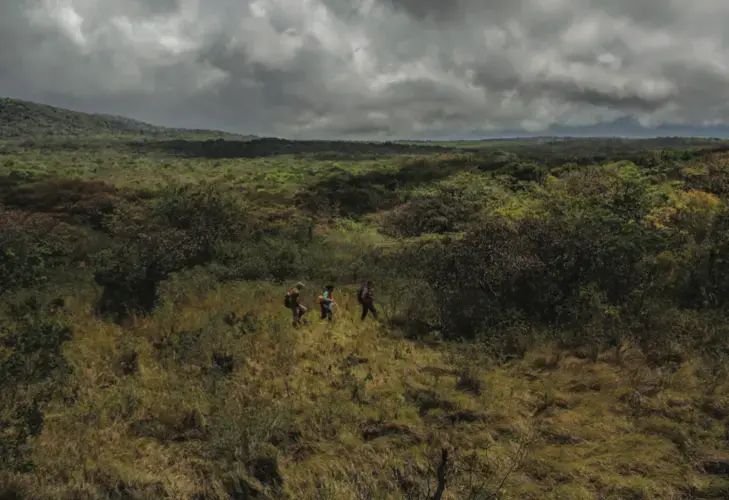
Fisher says that if carbon fertilisation is at work at Rincón de la Vieja, there will be more carbon stored in patches of forest with higher CO2 concentrations. Soper, now back in her lab, didn’t discover evidence of that. But then this trip was always a dry run for a more intensive survey later. And even then, she says, it will probably require sampling many more trees to detect carbon fertilisation. To get the sort of data required, Fisher hopes NASA will fund a vastly expanded research campaign, including ground surveys of many more plots and low-level flights by some of the agency’s best drones.
But David Schimel, another NASA biologist, is optimistic that the project could produce a breakthrough. Rincón de la Vieja is “an unexpected and wonderful window for seeing what happens in forests that have experienced high CO2 for centuries,” he says. In a best-case scenario, the volcano research could complement Lapola’s new Amazon experiment to give us a first real glimpse of how tropical forests’ capacity to absorb carbon will fare in our future atmosphere.
One thing is for sure: we need to know how this plays out, because we’re relying on Earth’s natural carbon sinks to buy us time while we reduce carbon emissions to net zero and maybe even suck it out of the air with carbon-capture technologies. “We’re going to need every little bit of help that mother nature will give us,” says Schimel. “We need to know what we can count on.”
The Other Carbon Sinks
Ecosystems that absorb more carbon than they release are known as carbon sinks because they effectively store greenhouse gases, reducing their levels in the atmosphere. If we are to stand any chance of keeping global warming to 1.5°C above pre-industrial levels, the target set by the Paris climate deal, or even the more realistic 2°C target, we are going to need them. This is why scientists are so concerned about the fate of the world’s tropical forests, one of our biggest carbon sponges (see main story). But these jungles aren’t the only possible natural carbon sink that researchers have been investigating.
Grasslands soak up a lot of carbon dioxide via photosynthesis. But they don’t end up storing much because their dead stems and fronds often decay quickly, returning carbon to the air. Peatlands, which include some grasslands, but also forests and tundra, lock up huge amounts of carbon in their soil. This is because they are uniquely rich in dead and decaying plant matter. In fact, peatlands store 20 percent of the carbon in all the world’s soil, or as much as all the world’s above-ground vegetation, despite covering just 3 percent of Earth’s surface. Yet it is important to recognise that peatlands don’t remove much CO2 from the atmosphere every year. Their vast stocks have accumulated over hundreds or thousands of years.
Most of the CO2 plants soak up from the air – some 12 gigatonnes per year – is absorbed in forests, which cover 30 percent of Earth’s land. That’s roughly a third of the annual emissions we create by burning fossil fuels. For years, many scientists thought that tropical jungle absorbed more carbon than any other forests. But recent studies suggest that climate change is causing carbon uptake of tropical woodlands to be outstripped by forests elsewhere.
Take boreal forests, for example. These don’t grow as voraciously as tropical forests, limiting how much carbon they can absorb per square kilometre. But they still have a vast potential because they’re so large. And they might benefit from carbon fertilisation, a process by which additional carbon in the atmosphere boosts growth. What’s more, temperatures are rising faster in the Arctic than anywhere else, and that is making it possible for boreal forests to expand into once inhospitable tundra.





